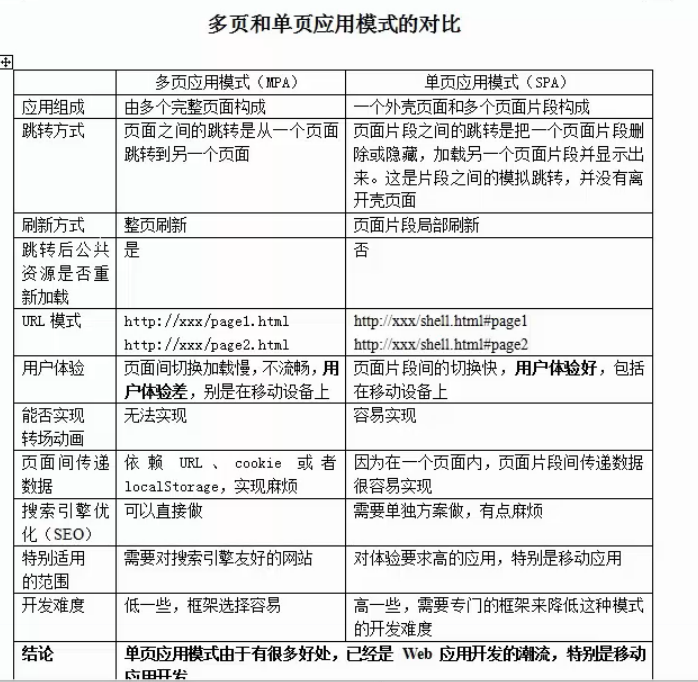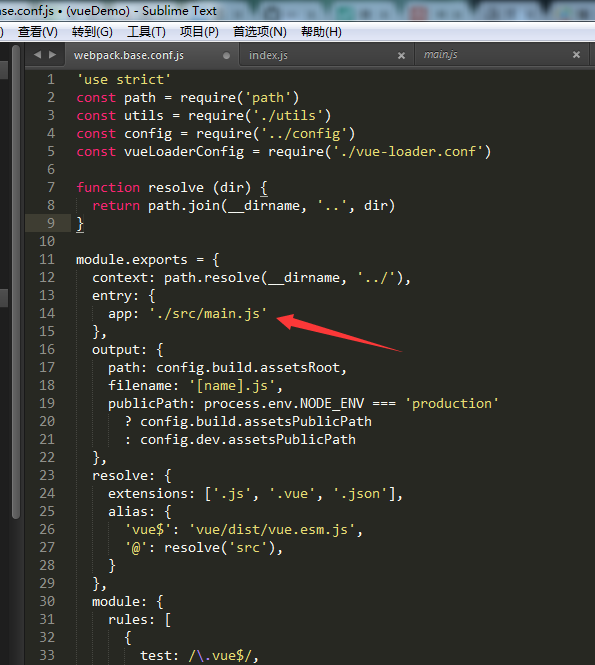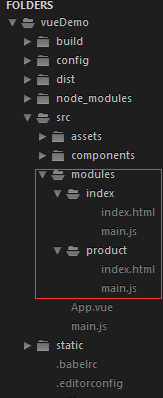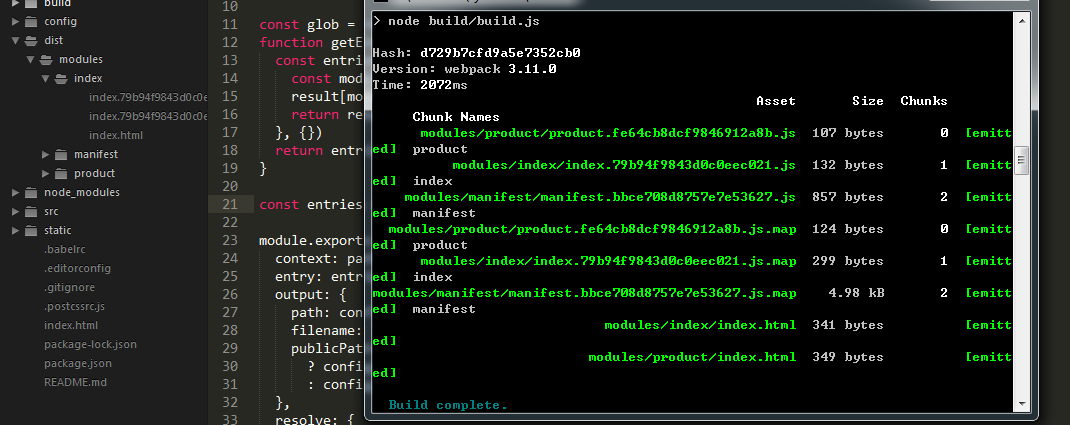vue搭建多页面开发环境
自从习惯开发了单页面应用,对多页面的页面间的相互跳转间没有过渡效果、难维护极度反感。但是最近公司技术老大说,当一个应用越来越大的时候单页面模式应付不来,但是没讲怎么应付不来,所以还得自己去复习一遍这两者的区别:

这样对比的话,单页面的优势确实很大,但当我自己去打开某宝,某东的移动端页面时,确实它们都是多页面应用。为什么?我能想到的就几点:
1.单页面使用的技术对低版本的浏览器不友好,大公司还得兼顾使用低版本浏览器的用户啊
2.功能模块开发来说,比如说单页面的业务公用组件,有时候你都不知道分给谁开发
3.seo优化吧(PS:既然是大应用应该很多人都知道,为什么还要做搜索引擎优化)
--------------------------------------------------华丽分割线------------------------------------------------------------------------------------
公司开发移动端使用的技术是vue,其实老大在要求使用多页面开发的时候,已经搭了一个vue多页面的脚手架供给我们去使用,但是我去看了看源码的时候写得很一般,所以决定自己重新去写过。
思路:
由于vue-cli已经写好了单页面的webpack文件,不去改动之前是它默认的一个页面引用打包的资源。既然是多页面,那么把webpack入口文件改成多个就好了啊。未改动时的webpack.base.conf.js(这个JS的功能主要在于全局配置,比如入口文件,出口文件,解析规则等)

1 // 把箭头部分的入口文件改为以下
2 entry: {
3 'index': '..../main.js' // 注意省略号是实际开发时的项目路径
4 'product': '..../main.js'
5 }
但是这样做效率得多低下,每增加一个新页面就要手动去添加新的入口,所以这里把入口文件封装为一个函数:

1 /**
2 * 获取多页面入口文件
3 * @globPath 文件路径
4 */
5 const glob = require('glob')
6 function getEntries(globPath) {
7 const entries = glob.sync(globPath).reduce((result, entry) => {
8 const moduleName = path.basename(path.dirname(entry)) // 获取模块名称
9 result[moduleName] = entry
10 return result
11 }, {})
12 return entries
13 }

注意在使用nodejs的glob模块之前,记得先下载依赖
测试一下这个函数

然后把webpack.base.config.js改为如下:

1 'use strict'
2 const path = require('path')
3 const utils = require('./utils')
4 const config = require('../config')
5 const vueLoaderConfig = require('./vue-loader.conf')
6
7 function resolve (dir) {
8 return path.join(__dirname, '..', dir)
9 }
10
11 const glob = require('glob')
12 function getEntries (globPath){
13 const entries = glob.sync(globPath).reduce((result, entry) => {
14 const moduleName = path.basename(path.dirname(entry)) // 获取模块名称
15 result[moduleName] = entry
16 return result
17 }, {})
18 return entries
19 }
20
21 const entries = getEntries('./src/modules/**/*.js')
22
23 module.exports = {
24 context: path.resolve(__dirname, '../'),
25 entry: entries, // 改动部分
26 output: {
27 path: config.build.assetsRoot,
28 filename: '[name].js',
29 publicPath: process.env.NODE_ENV === 'production'
30 ? config.build.assetsPublicPath
31 : config.dev.assetsPublicPath
32 },
33 resolve: {
34 extensions: ['.js', '.vue', '.json'],
35 alias: {
36 'vue$': 'vue/dist/vue.esm.js',
37 '@': resolve('src'),
38 }
39 },
40 module: {
41 rules: [
42 {
43 test: /\.vue$/,
44 loader: 'vue-loader',
45 options: vueLoaderConfig
46 },
47 {
48 test: /\.js$/,
49 loader: 'babel-loader',
50 include: [resolve('src'), resolve('test'), resolve('node_modules/webpack-dev-server/client')]
51 },
52 {
53 test: /\.(png|jpe?g|gif|svg)(\?.*)?$/,
54 loader: 'url-loader',
55 options: {
56 limit: 10000,
57 name: utils.assetsPath('img/[name].[hash:7].[ext]')
58 }
59 },
60 {
61 test: /\.(mp4|webm|ogg|mp3|wav|flac|aac)(\?.*)?$/,
62 loader: 'url-loader',
63 options: {
64 limit: 10000,
65 name: utils.assetsPath('media/[name].[hash:7].[ext]')
66 }
67 },
68 {
69 test: /\.(woff2?|eot|ttf|otf)(\?.*)?$/,
70 loader: 'url-loader',
71 options: {
72 limit: 10000,
73 name: utils.assetsPath('fonts/[name].[hash:7].[ext]')
74 }
75 }
76 ]
77 },
78 node: {
79 // prevent webpack from injecting useless setImmediate polyfill because Vue
80 // source contains it (although only uses it if it's native).
81 setImmediate: false,
82 // prevent webpack from injecting mocks to Node native modules
83 // that does not make sense for the client
84 dgram: 'empty',
85 fs: 'empty',
86 net: 'empty',
87 tls: 'empty',
88 child_process: 'empty'
89 }
90 }

注意我的多页面目录:

---------------------------------------华丽分割线----------------------------------------------------------------------
公共配置搞完之后是打包文件:webpack.prod.conf.js,打包文件的修改主要是输出文件的配置,因为要对应入口文件的文件夹,还有就是一个页面对应一个htmlwebpackplugin配置,这个配置是加在文件的plugins里面的,按照上面的消除手动加入配置的思路这里也加入htmlwebpackplugin的配置函数

/**
* 页面打包
* @entries 打包文件
* @config 参数配置
* @module 使用的主体
*/
const HtmlWebpackPlugin = require('html-webpack-plugin')
function pack (entries, module) {
for (const path in entries) {
const conf = {
filename: `modules/${path}/index.html`,
template: entries[path], // 模板路径
inject: true,
chunks: ['manifest', 'vendor', path] // 必须先引入公共依赖
}
module.plugins.push(new HtmlWebpackPlugin(conf))
}
}

最终打包文件改为如下

'use strict'
const path = require('path')
const utils = require('./utils')
const webpack = require('webpack')
const config = require('../config')
const merge = require('webpack-merge')
const baseWebpackConfig = require('./webpack.base.conf')
const CopyWebpackPlugin = require('copy-webpack-plugin')
const HtmlWebpackPlugin = require('html-webpack-plugin')
const ExtractTextPlugin = require('extract-text-webpack-plugin')
const OptimizeCSSPlugin = require('optimize-css-assets-webpack-plugin')
const UglifyJsPlugin = require('uglifyjs-webpack-plugin') const env = require('../config/prod.env') const glob = require('glob')
function getEntries (globPath){
const entries = glob.sync(globPath).reduce((result, entry) => {
const moduleName = path.basename(path.dirname(entry)) // 获取模块名称
result[moduleName] = entry
return result
}, {})
return entries
} const entries = getEntries('./src/modules/**/*.html') // 获取多页面所有入口文件 const webpackConfig = merge(baseWebpackConfig, {
module: {
rules: utils.styleLoaders({
sourceMap: config.build.productionSourceMap,
extract: true,
usePostCSS: true
})
},
devtool: config.build.productionSourceMap ? config.build.devtool : false,
output: {
path: config.build.assetsRoot,
filename: 'modules/[name]/[name].[chunkhash].js',
// publicPath: '/' // 改为相对路径
// chunkFilename: utils.assetsPath('js/[id].[chunkhash].js')
},
plugins: [
// http://vuejs.github.io/vue-loader/en/workflow/production.html
new webpack.DefinePlugin({
'process.env': env
}),
new UglifyJsPlugin({
uglifyOptions: {
compress: {
warnings: false
}
},
sourceMap: config.build.productionSourceMap,
parallel: true
}),
// extract css into its own file
new ExtractTextPlugin({
filename: utils.assetsPath('css/[name].[contenthash].css'),
// Setting the following option to `false` will not extract CSS from codesplit chunks.
// Their CSS will instead be inserted dynamically with style-loader when the codesplit chunk has been loaded by webpack.
// It's currently set to `true` because we are seeing that sourcemaps are included in the codesplit bundle as well when it's `false`,
// increasing file size: https://github.com/vuejs-templates/webpack/issues/1110
allChunks: true,
}),
// Compress extracted CSS. We are using this plugin so that possible
// duplicated CSS from different components can be deduped.
new OptimizeCSSPlugin({
cssProcessorOptions: config.build.productionSourceMap
? { safe: true, map: { inline: false } }
: { safe: true }
}),
// generate dist index.html with correct asset hash for caching.
// you can customize output by editing /index.html
// see https://github.com/ampedandwired/html-webpack-plugin
// keep module.id stable when vendor modules does not change
new webpack.HashedModuleIdsPlugin(),
// enable scope hoisting
new webpack.optimize.ModuleConcatenationPlugin(),
// split vendor js into its own file
new webpack.optimize.CommonsChunkPlugin({
name: 'vendor',
minChunks (module) {
// any required modules inside node_modules are extracted to vendor
return (
module.resource &&
/\.js$/.test(module.resource) &&
module.resource.indexOf(
path.join(__dirname, '../node_modules')
) === 0
)
}
}),
// extract webpack runtime and module manifest to its own file in order to
// prevent vendor hash from being updated whenever app bundle is updated
new webpack.optimize.CommonsChunkPlugin({
name: 'manifest',
minChunks: Infinity
}),
// This instance extracts shared chunks from code splitted chunks and bundles them
// in a separate chunk, similar to the vendor chunk
// see: https://webpack.js.org/plugins/commons-chunk-plugin/#extra-async-commons-chunk
new webpack.optimize.CommonsChunkPlugin({
name: 'app',
async: 'vendor-async',
children: true,
minChunks: 3
}), // copy custom static assets
new CopyWebpackPlugin([
{
from: path.resolve(__dirname, '../static'),
to: config.build.assetsSubDirectory,
ignore: ['.*']
}
])
]
}) if (config.build.productionGzip) {
const CompressionWebpackPlugin = require('compression-webpack-plugin') webpackConfig.plugins.push(
new CompressionWebpackPlugin({
asset: '[path].gz[query]',
algorithm: 'gzip',
test: new RegExp(
'\\.(' +
config.build.productionGzipExtensions.join('|') +
')$'
),
threshold: 10240,
minRatio: 0.8
})
)
} if (config.build.bundleAnalyzerReport) {
const BundleAnalyzerPlugin = require('webpack-bundle-analyzer').BundleAnalyzerPlugin
webpackConfig.plugins.push(new BundleAnalyzerPlugin())
} function pack (entries, module) {
for (const path in entries) {
const conf = {
filename: `modules/${path}/index.html`,
template: entries[path], // 模板路径
inject: true,
chunks: ['manifest', 'vendor', path] // 必须先引入公共依赖
}
module.plugins.push(new HtmlWebpackPlugin(conf))
}
} pack(entries, webpackConfig)
module.exports = webpackConfig

然后启动npm run build尝试打包文件

OK,多页面的打包完成
参考:http://blog.csdn.net/u013291076/article/details/53667382
vue搭建多页面开发环境的更多相关文章
- vue.js多页面开发环境搭建
利用 vue-cli 搭建的项目大都是单页面应用项目,对于简单的项目,单页面就能满足要求.但对于有多个子项目的应用,如果创建多个单页面,显示有点重复,特别是 node_modules 会有多份相同的. ...
- 用grunt搭建web前端开发环境
1.前言 本文章旨在讲解grunt入门,以及讲解grunt最常用的几个插件的使用. 2.安装node.js Grunt和所有grunt插件都是基于nodejs来运行的,如果你的电脑上没有nodejs, ...
- Xamarin Andro教程搭建Xamarin Androidid开发环境(一)
Xamarin Andro教程搭建Xamarin Androidid开发环境(一) "工欲善其事,必先利其器".对于程序员来说,编程的环境就是其手中的利器.如果没有一个合适方便的编 ...
- 快速搭建 Node.js 开发环境以及加速 npm
如何快速搭建 node 开发环境 npm 超慢 github 无法打开的问题 于是我觉得应该写一篇文章解答所有这些起步问题,让新同学也能顺顺利利入门. 快速搭建 Node.js 开发环境 如果你想长期 ...
- Win7的64位系统如何搭建安卓Android开发环境
在搭建安卓Android开发环境,那么现在比较主流的Win7的64位操作系统如何搭建呢?其实很简单,不需要设置任何环境变量,只需要下载两个程序包(ADT和JDK),下载的时候注意选择相应的64位程序包 ...
- 优化单页面开发环境:webpack与react的运行时打包与热更新
前面两篇文章介绍初步搭建单页面应用的开发环境: 第一篇:使用webpack.babel.react.antdesign配置单页面应用开发环境 第二篇:使用react-router实现单页面应用路由 这 ...
- React Native开发 - 搭建React Native开发环境
移动开发以前一般都是原生的语言来开发,Android开发是用Java语言,IOS的开发是Object-C或者Swift.那么对于开发一个App,至少需要两套代码.两个团队.对于公司来说,成本还是有的. ...
- 从零开始搭建Go语言开发环境
一步一步,从零搭建Go语言开发环境. 安装Go语言及搭建Go语言开发环境 下载 下载地址 Go官网下载地址:https://golang.org/dl/ Go官方镜像站(推荐):https://gol ...
- vs2017搭建linux c++开发环境
最近一直在阅读ovs的源码,看到用户态代码的时候,需要对用户态的代码进行调试,一开始想直接使用linux中的GDB进行调试,但是ovs的工程太过于复杂,从网上找了些文章,发现vs2017能够支持lin ...
随机推荐
- 剑指offer PART 2
剑指offer PART 2 书点击自取 提取码: njku 标签(空格分隔): 笔记 C++知识点: 1.面向对象的特性 2.构造函数 3.析构函数 4.动态绑定 5.常用的设计模式 6.UML图 ...
- license
http://139.199.89.239:1008/4571ab86-eb0d-4d2b-999e-37406bb8ba38 _~~~ rO0ABXNyAChjb20uemVyb3R1cm5hcm9 ...
- Dom事件流、冒泡、捕获
Dom事件流 dom的结构是一个倒立的树状结构.当一个html元素触发事件时,事件会在dom的根节点和触发事件的元素节点之间传播,中间的节点都会收到该事件. 捕获:div元素触发事件时,事件先从根节点 ...
- 浅谈Spring中的IOC容器
一.IOC.DI基本概念 IoC(Inversion of Control)控制反转指的是把对象的创建,初始化,销毁等工作交给容器来做.由容器控制对象的生命周期(传统方式中是由我们程序员主动创建对象. ...
- 模板基础model
一.Django-model基础 1.1ORM 映射关系: 表名<---------->类名 字段<---------->属性 表记录<---------->类实例 ...
- 理解特性attribute 和 属性property的区别 及相关DOM操作总结
查一下英语单词解释,两个都可以表示属性.但attribute倾向于解释为特质,而property倾向于解释私有的.这个property的私有解释可以更方便我们下面的理解. 第一部分:区别点 第一点: ...
- 反编译看java for-each循环
java 1.5发行版引入的for-each循环.(引自<Effective Java>中文版第二版 第46条) 如以下对数组列表的for-each循环示例: public class F ...
- Https,Http,TCP,IP的一些理解
网络模型分为7层,应用层,表现层,会话层,传输层,网络层,链路层,物理层,每一层有很多不同的协议. http:属于应用层的协议,负责的是数据以什么结构传输也可以说成是打包成什么样子 SSL/TLS:属 ...
- 携带cookie的跨域访问
携带cookie的跨域解决方案 有的时候访问后台的请求需要携带cookie以供后台分析,比如jQuery的ajax请求: $.ajax({ url: a_cross_domain_url, xhrFi ...
- ie页面数据导入共享版
为了解决自动输入号码的正确率,原来的版本一直采用鼠标检测的方法.但是这个方法在其他ie平台的使用不太方便.于是直接检测ie的方法.现在的这个版本完全不需要鼠标的检测.方便而且快速精准可靠. 经过作者的 ...
